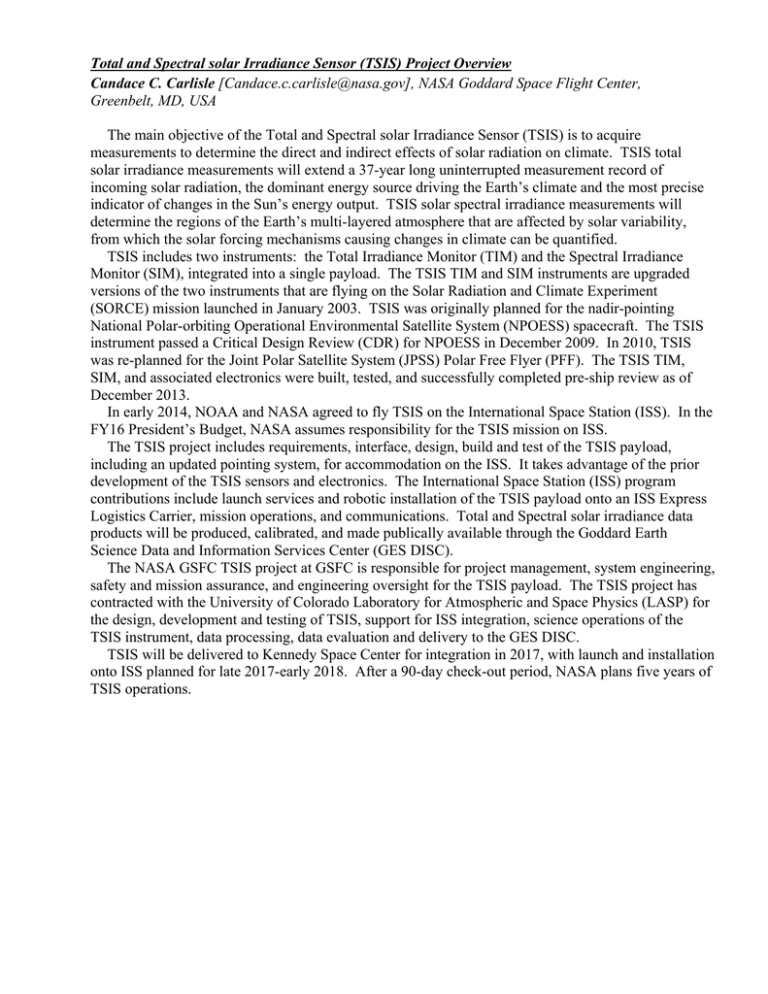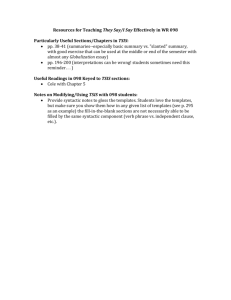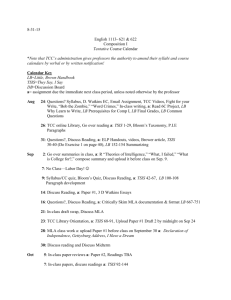Total and Spectral solar Irradiance Sensor (TSIS) Project Overview
advertisement

Total and Spectral solar Irradiance Sensor (TSIS) Project Overview Candace C. Carlisle [Candace.c.carlisle@nasa.gov], NASA Goddard Space Flight Center, Greenbelt, MD, USA The main objective of the Total and Spectral solar Irradiance Sensor (TSIS) is to acquire measurements to determine the direct and indirect effects of solar radiation on climate. TSIS total solar irradiance measurements will extend a 37-year long uninterrupted measurement record of incoming solar radiation, the dominant energy source driving the Earth’s climate and the most precise indicator of changes in the Sun’s energy output. TSIS solar spectral irradiance measurements will determine the regions of the Earth’s multi-layered atmosphere that are affected by solar variability, from which the solar forcing mechanisms causing changes in climate can be quantified. TSIS includes two instruments: the Total Irradiance Monitor (TIM) and the Spectral Irradiance Monitor (SIM), integrated into a single payload. The TSIS TIM and SIM instruments are upgraded versions of the two instruments that are flying on the Solar Radiation and Climate Experiment (SORCE) mission launched in January 2003. TSIS was originally planned for the nadir-pointing National Polar-orbiting Operational Environmental Satellite System (NPOESS) spacecraft. The TSIS instrument passed a Critical Design Review (CDR) for NPOESS in December 2009. In 2010, TSIS was re-planned for the Joint Polar Satellite System (JPSS) Polar Free Flyer (PFF). The TSIS TIM, SIM, and associated electronics were built, tested, and successfully completed pre-ship review as of December 2013. In early 2014, NOAA and NASA agreed to fly TSIS on the International Space Station (ISS). In the FY16 President’s Budget, NASA assumes responsibility for the TSIS mission on ISS. The TSIS project includes requirements, interface, design, build and test of the TSIS payload, including an updated pointing system, for accommodation on the ISS. It takes advantage of the prior development of the TSIS sensors and electronics. The International Space Station (ISS) program contributions include launch services and robotic installation of the TSIS payload onto an ISS Express Logistics Carrier, mission operations, and communications. Total and Spectral solar irradiance data products will be produced, calibrated, and made publically available through the Goddard Earth Science Data and Information Services Center (GES DISC). The NASA GSFC TSIS project at GSFC is responsible for project management, system engineering, safety and mission assurance, and engineering oversight for the TSIS payload. The TSIS project has contracted with the University of Colorado Laboratory for Atmospheric and Space Physics (LASP) for the design, development and testing of TSIS, support for ISS integration, science operations of the TSIS instrument, data processing, data evaluation and delivery to the GES DISC. TSIS will be delivered to Kennedy Space Center for integration in 2017, with launch and installation onto ISS planned for late 2017-early 2018. After a 90-day check-out period, NASA plans five years of TSIS operations.



